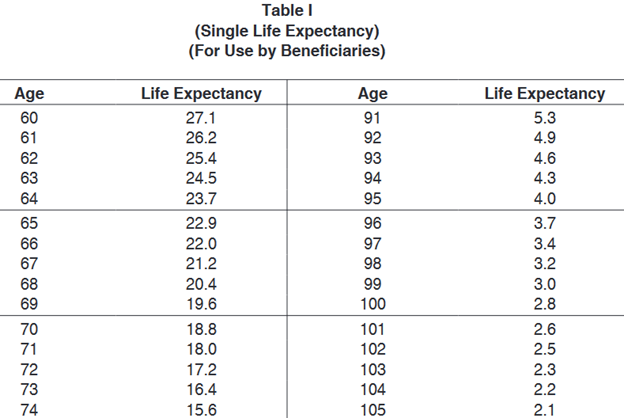Understanding the New RMD Rules for Non-Spousal Beneficiaries of Inherited IRAs - Part II


Learn more about your benefits and retirement planning at our No-Cost webinars, featuring Ed Zurndorfer -
The following example illustrates:
Example 1. Ida is age 65 when she passes away on January 30, 2023. Ida’s sister Muriel is listed as the sole beneficiary of Ida’s traditional IRA. Muriel is age 62 in 2023 and therefore qualifies as an EDB because she is three years younger than Ida. Muriel’s first annual RMD from the inherited IRA will occur during 2024, at which time Muriel will be age 63. Muriel uses the IRS’ Single Life Expectancy Table to calculate the initial RMD factor in 2024. From Table 1 shown above, Muriel’s initial RMD factor in 2024 (age 63) will be 24.5 years.
EDB Cannot Be More than 10 Years Younger
An EDB cannot be more than 10 years younger than the deceased IRA owner. The “not more than 10 years younger” EDB category can include an enormous number of individuals. Subtracting 10 years from the IRA owner’s age and older individuals than the IRA owner includes quite a few individuals who will qualify as an EDB.
Note that “not more than 10 years younger” is measured from the deceased IRA owner’s exact birthdate. SECURE Act 2.0 dictates that EDBs are established based on a specific age as of the date of death. The following example illustrates:
Example 2. Richard was age 76.5 when he died on April 30, 2023. Any of Richard’s beneficiaries who are exactly age 66.5 or older as of April 30, 2023, will qualify as Richard’s EDB. Allen is listed as beneficiary of Richard’s IRA. But Allan just turned 66 when Richard died on April 30, 2023. Allan is not an EDB because EDBs are determined on the day of Richard’s death. Allan thinks that if he waits 6 months to claim the inherited IRA, he will become an EDB and will be able to “age into” the right to “stretch” inherited IRA payments over his lifetime. Allan is incorrect. The “not more than 10 years younger” is firmly determined on the day that Richard died. “Not more than 10 years younger” is measured from the IRA owner’s exact birthdate to the designated beneficiary’s exact birthdate.
What Happens to Beneficiaries Who Do Not Qualify as EDBs?
In addition to creating EDBs, SECURE Act 2.0 established a 10-year payout period for living beneficiaries who do not qualify as EDBs. These are known as non-eligible designated beneficiaries (NEDBs). NEDBs are not permitted to take lifetime distributions (based on their life expectancy) from their inherited IRAs. Instead, NEDBs must adhere to an expedited 10-year payout schedule.
The 10-year period begins in the year after the year of death of the IRA owner and ends on December 31 of the 10th year after the year of death. It does not end on the 10th anniversary of this date of death.
Life Expectancy Tables Used on RMD Calculations Within the 10-Year Period
Under the IRS proposed regulations, NEDBs subject to the 10-year rule are also required to take RMDs in years 1 through 9 of the 10-year period if the IRA owner died on or after his or her required beginning date (RBD). The RBD depends on when the IRA owner was born, as shown in the following table:
Required Beginning Date by Date of Birth
| Date of Birth | Applicable Age | Required Beginning Date (RBD) |
| Before July 1,1949 | 70.5 | Has already passed. |
| July 1, 1949 – December 31, 1950 | 72 | Has already passed. |
| January 1, 1951 – December 31, 1959 | 73 | April 1 following the year the IRA owner becomes age 73. |
| After December 31, 1959 | 75 | April 1 following the year the IRA owner becomes age 75. |
If the IRA owner dies before reaching his or her RBD, only the 10-year period rule applies with no RMDs in years 1 through 9. What that means is that a NEBD can wait until the end of the 10th year and withdraw the entire inherited IRA in a lump-sum. Although this allows for continued tax-deferred growth in the inherited IRA, the lump-sum payment could result in additional taxes by possibly pushing the NEBD into a higher federal marginal tax bracket.
To calculate RMDs within the 10-year period, the NEBD uses his or her own single life expectancy – not the deceased IRA owner’s life expectancy – for the first RMD due by December 31 of the year following the year of death of the IRA owner. That life expectancy factor is determined under the IRS Single Life Expectancy Table and is based on the NEBD’s age in the year of the first RMD (the year after the year of death of the IRA owner). For each subsequent year, the RMD factor is reduced by 1.0.
The following two examples illustrate the 10-year period for NEDBs:
Example 3. Elizabeth, age 65, died July 15, 2022. The beneficiary of her IRA is her son William. Since Elizabeth died before her RBD, William is subject only to the 10-year rule. William decides to withdraw the inherited IRA each year over a 10-year period, starting with his first withdrawal by December 31,2023 and his last withdrawal made by December 31, 2031.
For his first withdrawal, to be made by December 31, 2023, the withdrawal is calculated as follows:
(Inherited IRA balance as of 12/31/2022)/10
For William’s second inherited IRA withdrawal, to be made by December 31, 2024, the withdrawal is calculated as follows:
(Inherited IRA balance as of 12/31/2023)/10
For his final inherited IRA withdrawal, to be made by December 31, 2032, William must withdraw the remaining IRA account balance.
Example 4. Christopher, age 82, dies in 2022. The beneficiary of his IRA is his son Daniel, age 56. Daniel is a NEDB and must abide by the 10-year rule. Since Christopher died after his RBD, Daniel will have to take annual RMD’s from the inherited IRA based on his own single life expectancy for the years 2023-2031, the years 1 through 9 of the 10-year period. The 2023 RMD is based on a 29.8 life expectancy factor, the factor for a 57-year-old. This is because Daniel will be aged 57 during 2023. The initial 29.8 factor is reduced by one each successive year (28.8 in 2024, 27.8 in 2025, etc.). Whatever remains in the account in the year 2032 will be the RMD for the year 2032 and must be withdrawn in its entirety by December 31, 2032.
Individuals who became non-spousal beneficiaries of inherited IRAs since 2020 with additional problems and questions are encouraged to speak with their financial and tax advisors.
Edward A. Zurndorfer is a CERTIFIED FINANCIAL PLANNER™ professional, Chartered Life Underwriter, Chartered Financial Consultant, Chartered Federal Employee Benefits Consultant, Certified Employees Benefits Specialist and IRS Enrolled Agent in Silver Spring, MD. Tax planning, Federal employee benefits, retirement and insurance consulting services offered through EZ Accounting and Financial Services, and EZ Federal Benefits Seminars, located at 833 Bromley Street - Suite A, Silver Spring, MD 20902-3019 and telephone number 301-681-1652. Raymond James is not affiliated with and does not endorse the opinions or services of Edward A. Zurndorfer or EZ Accounting and Financial Services. The information has been obtained from sources considered to be reliable, but we do not guarantee that the foregoing material is accurate or complete. While we are familiar with the tax provisions of the issues presented herein, as Financial Advisors of RJFS, we are not qualified to render advice on tax or legal matters. You should discuss tax or legal matters with the appropriate professional.




